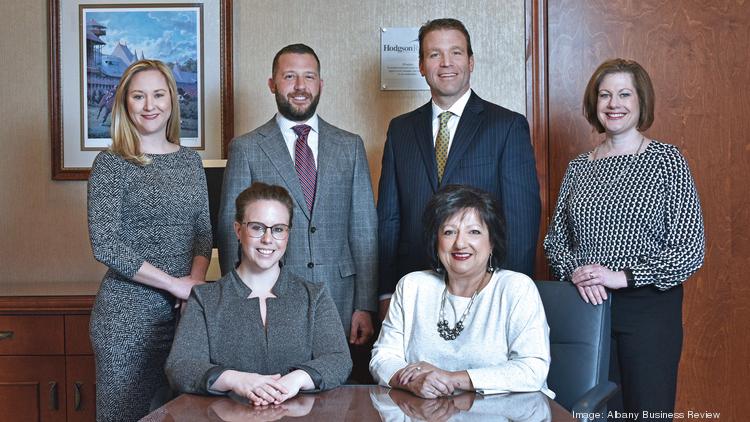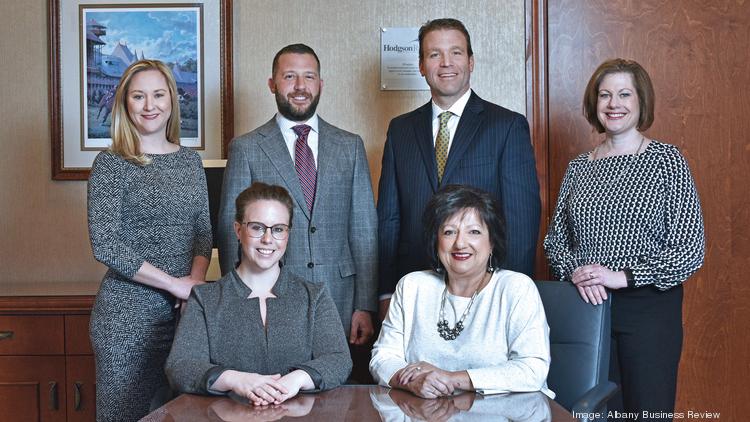 How do you help your company or clients monitor social media? How does your strategy change depending on the platform? Has social media impacted crisis communication? Law firm Hodgson Russ and the Albany Business Review hosted a discussion to answer these questions and more. Cindy Applebaum, market president and publisher of the Albany Business Review, moderated the discussion.
How do you help your company or clients monitor social media? How does your strategy change depending on the platform? Has social media impacted crisis communication? Law firm Hodgson Russ and the Albany Business Review hosted a discussion to answer these questions and more. Cindy Applebaum, market president and publisher of the Albany Business Review, moderated the discussion.
What are some of the best practices businesses can use for social media accounts?
Tracy Cantele, Marketing Manager, Ginsberg’s Foods: Be as consistent as possible and ignore nothing.
Ali Skinner, VP, Communications Strategy, CDPHP: Start with a policy. You want to know who is posting on your behalf. Have a couple of people as a backup. Always be monitoring and paying attention.
Teal Vivacqua Hoyos, Director, Marketing and Communications, Plug Power: We try to keep a social media calendar. If we are able to map out different campaigns that we want to have a conversation about, we can better align them to all come back to the same point at the end of the month, or the end of the quarter, to keep us on point with what we want to accomplish.
Andrew Mangini, Partner, Gramercy Communications: We advise our clients to be genuine, establish a voice and know your goals and why you are on social media. There are a lot of different communications channels to use, and you should use them all differently. Understand why you’re using social media, who the target audience is, and have a plan for the message that you want to convey to that certain stakeholder group.
Rose Miller, President, Pinnacle HR: I see so many companies without any communications and technology policies, but more importantly than just having the policy is to actually have a training session. It is so much a part of what we do today that you really need to have a special session with everyone in the company about what is acceptable and what isn’t.
Christian Soller, Managing Partner, Hodgson Russ LLP: Always stay positive, no matter how tempting it may be, not to be. Users recognize when a response is rational and positive, and they appreciate that. If there’s somebody impugning you or your business, stay positive. Try to address it publicly and quickly, if possible. Often times, it all goes away.
Do you help your clients monitor their social media? Do you provide them feedback on it?
Miller: We usually get the call when something’s wrong. We are usually putting out the fires when we get a call. We’d like to be more proactive, and that starts with training them on the policy, and actually guiding them to what they have to have in their policies, but we’re not there. We’re not there monitoring it, so when things go wrong, they usually blow up pretty badly.
Mangini: For some of our clients, we run their social media soup-to-nuts. For others, we advise them on what the editorial calendar looks like. Others just call us when something catches fire. I do a lot of our crisis communications training. We always spend a fair amount of time on social media, and how to use it and how to respond. One of the things that I advise people to do is, when you see posts come onto the page or comments on a post, have a mindset of green, yellow or red in your mind, and to view every post through that lens.
Green means it’s perfectly fine, allow it. Yellow means monitor, to see if something is questionable and gains traction. Red is that break-glass-in-case-of-emergency, let’s rally the SEAL team and figure out how we want to handle this. If possible, try to take public conversations and make them private. Try to make it clear in the public that you are addressing the problem, and then solve it offline. Then circle back in that public arena to close the loop for everyone else that may be following that chain.
Miller: It’s really difficult for employers to accept some things that people post that aren’t attractive to company. Anything that they post about their pay, or their benefits, or their work conditions, even if it’s quite damaging to your professional image, you can’t tell them that they can’t post that. If they say, “The president of the company’s ugly, and he wears the same clothes every day,” you can say, “That’s not allowed. You can’t disrespect the president that way.”
What do businesses need to be careful of on social media?
Vivacqua Hoyos: First and foremost, making sure that the company’s persona is shared through their social media feeds, is very important. You work very hard to have a brand, maintain that brand and build your brand equity. Your social media channels are really a reflection of that brand. A company that loses sight of that and shows a different face on social media than they want their brand to portray does not do them any service to what they, as an organization, worked so hard to build.
Skinner: Being in the health care space, we have to be very careful of personal health information. While consumers are often very generous in sharing their personal information online and talking about it, maybe it could be a medical issue or a claim that was either approved, denied, or something like that, we can’t engage in that type of conversation. So, we take it offline.
Cantele: One of the biggest things is to make sure that you consistently talk about your brand and the manner you want it portrayed in. You have to be careful on social media to reread the post before it goes live because one word can change it all. When we write something, it never gets published right away. We read it three times later and have somebody else look at it and make sure it’s out there correctly.
How much conversation takes place internally before you actually put your social media strategy in place?
Cantele: A lot of times what we talk about is our people. We’re proud of our employees. As a 110-year-old company, we’ve been around that long because of our people. So we talk about them a lot. Who we are is not just a food distributor, but the people behind it. The strategy really comes from listening to what senior staff is directing and thinking about in the future.
Skinner: Health insurance is really complicated. I started at CDPHP about eight years ago, and we had no social media presence online. I remember my boss at the time saying, “Nobody wants to ‘like’ their health insurance company.” Health insurance doesn’t really sound cool, right? It’s not food, it’s not celebrities, it’s not a lot of the things that you traditionally see online. What we try to do, is we try to be helpful to people. We try to distill very complex topics and information into things that are digestible on social media. We also try to be part of other people’s conversations.
Vivacqua Hoyos: Although we’re a B2B company, we have a lot of different audiences that pay very stringent attention to us. This includes the media, investors, customers and the government at some points in time. Sustainability and new energy technologies are becoming very important in the industry. We make very strong efforts to provide thought-leadership information when we’re building a strategy around what we share, how we share, how often we share.
We post maybe two to three times a week, and this varies. We try to map all of that back to, is this messaging appropriate for all of these different audiences? Will they all see value at some level? If we answer yes at the end of that, we feel that our strategy is still on point.
How do you handle employees’ personal social media and sharing their own personal experiences as they relate back to clients?
Mangini: When we’re talking about posts that staff members or employees have, it’s important to let everyone know that they’re a representative and a spokesperson of the brand, whether they want to be or not. If they’re someone who has identified as an employee of ‘X,’ anything they do reflects upon the brand. That’s why it’s important to have that social media policy in place because anything they do in the public world around social media can be tied back to your brand, whether it’s good or bad.
Skinner: I’m in a unique position because not only do I manage the social media, but I also am a spokesperson for the organization. My policy for myself, and for my team, is that we really don’t trash talk any brand online. I could have a terrible experience at any given company but I would never say anything negative about that. I don’t know if they are a current client, if they could be a future client, or what other ways we’re interconnected. You don’t want it to ever come back to you.
Cantele: I had a worst-case scenario of a star performer of our company who had posted on his social media page and got into a conversation with someone that they had ‘Liked’ as a ‘Friend.’ This person called the company and asked that they be fired. I get the voicemail to this effect. I listen to it with disbelief, get off the phone and realize they didn’t leave a name or phone number to call them back. We have a social media policy, which has now been morphed even more from this incident.
I had to go to the employee and said, “I got a call today.” It was really eye-opening for this employee because it was nothing that he thought anything about until this came to light. This was a star performer, and it really changed what he does. I couldn’t share it, but I was really glad that he started to share, “You need to be careful what you say on your own page because you say you work for Ginsberg’s Foods and you need to be cognizant of that.”
Skinner: A lot of us manage multiple accounts on one phone, and that’s a very scary thing sometimes. For example, on Twitter, I think I have four, and one of those is CDPHP. You have to be very careful that you are on the right account when you are posting anything personal. I think that it’s also why I take a pretty conservative approach when I’m posting anything on my personal page, too.
Can you describe one of the worst situations that you’ve been involved in that included social media?
Miller: The top of mind one is knowing who to give access to your Facebook page to post. One client had a very free-flowing attitude about who can post to their company Facebook. There was this tangled web of relationships going on in the workplace and some hard feelings about it. An upset employee of the people having an affair had a video of their goings-on and it got posted to the company website. In the background is the company logo, even.
The FBI gets called when that happens. We had to do an investigation and work with the authorities in their own investigation. We terminated all of the complicit people, and then trained the rest of the organization about reporting these sorts of things internally.
Soller: There are obviously things that you can do from a legal standpoint to address those sorts of extreme examples. An example like that may warrant actually skipping over the cease and desist letter, which is generally the second step if your initial efforts to amicably resolve the issue fail, because the damage has already been done. So jumping right into a defamation or slander lawsuit may be warranted. But generally, again, particularly when the potentially damaging communication involves a customer, you should first try to resolve the dispute as best as you can and let the other users know that you did it or, at least, that you’re trying to, because it shows them that customer service is paramount.
Also, if the potentially damaging post is on Yelp or Facebook, for instance, there are steps that you can take directly with that website to try to get them internally to remove it, but this is tedious and difficult in general to do. You have to meet certain criteria to get them to remove the post from their end. So if this and all else fail, including your efforts to amicably resolve the dispute on the front end, a lawsuit asserting defamation claim may be an option, if you establish certain elements. Whatever they’re posting can’t be true because truth is the ultimate defense to defamation. If it’s injurious to your business, if it’s false, if it’s published to a bunch of different people or the public at large, then you may have the elements to move forward with that sort of lawsuit.
How has social media impacted crisis management?
Skinner: It’s instant. I like to look at things that could be considered negative and consider the opportunity there. When we have a situation where it would be considered crisis management, it’s an opportunity to connect instantly with your audience. It could be seen as being scary, but it’s also an opportunity to address the issue very quickly. From a PR perspective or any type of communication, in the past it would take maybe hours, days, to turn around your message.
Mangini: In the past, if you needed to communicate something to the public, what were your options? Ok, we’ll mail a letter. Everyone will get it in 48 hours. We’d post something on the website and hope people happen to find it. Or we’d send an email. And most people don’t open emails. You know if you post something on Facebook, it is going to ‘X’ number of followers right away. In some ways, it’s the only way to communicate something quickly.
A press release, you’re at the mercy of the media covering it. But social media is a way for you to build your own content and drive it to your audience right away. Sometimes, what you need to do in a crisis situation is communicate quickly to the people that are interested in your brand, invested in your brand, or watching your brand.
Vivacqua Hoyos: We try to always remember that a crisis communication plan should lead, not be led by your social communication channels. Having your crisis communication plan prepared before the crisis happens allows you, in the heat of the moment, to react in a way that the company, in calmer times, has agreed to react.
Mangini: Having a crisis communication plan is so important because when a crisis hits, the board has the entire communications cascade ready to go. We need different messages for different stakeholders and different folks within the organization. We need a certain script for the person who answers the phones. We need something else for our employees who may get emails from their clients or their customers. We need a different script for any of the comments that come through on social media. If we know we might get these six questions, here are the five responses that we’ll use. We also need a different type of statement for the media. All of these things need to happen almost immediately, and that’s why a crisis situation is so difficult because you never know where the attacks or inquiries are going to come from.
How has social media come into play in the hiring process?
Cantele: At this time, that’s nothing that we’ve ever done in our hiring process. Now that the question got asked, maybe we should.
Skinner: I don’t know if you’re allowed to do it. I think my advice for people who are in the job market would be, don’t post anything that you don’t want a future employer to see. I can’t really speak for our HR department because I don’t think you’re allowed to proactively go out there and search.
Miller: Don’t ever print it out and demonstrate that you did look. Do people look? Of course they do. They’re trying to get texture on this person, get to know them deeper than just a face-to-face interview, because the person can be a very skilled interviewer, right? HR would tend to not do it because you’re filtering. That’s what you’re doing by looking, and how are you going to guarantee that you didn’t bring your biases in when you see a picture? There’s age biases, there’s disability biases, there’s race biases, and you cannot guarantee that the viewer isn’t bringing those to the table. It’s a very dangerous practice.
Soller: But just generally, if it’s publicly accessible, you’re entitled to look, as long as you’re not employing any deception in going about getting the information, like posing as a friend of somebody on Facebook. As long as none of that is involved, and you’re just Google searching or looking for open accounts, it’s fair game. It’s out in the public domain.
Vivacqua Hoyos: It’s really for the safety of our own employees, and we hire an outsourced background check partner. They do the screening on our behalf, and will flag something if it seems like it could be problematic. What that does is take our hiring managers out of infringing on Section 7 of FMLA, taking that discrimination bias out of it, but still allows posts to be flagged if they seem problematic. That’s how we’ve gotten around seeing the seriousness of it but protecting our hiring managers from that.
Why don’t we see more local executives on social media? Is it scripted that way?
Mangini: If a local executive were to be on social media, they need to do it with a certain goal in mind. They need to realize that they truly are representative of the brand, more so than a lower-level staffer. Are they on social media to portray their personal life or their business life? You can be personal on Facebook. You can be business-focused on Twitter. You can be hyper-business-focused on LinkedIn.
What are the goals of social media interaction? Do you want to be viewed as a thought leader? Do you want to help push out your company’s message? Are you on social media as a hiring tool? Are you trying to raise your company’s profile? The organization needs to have a deep conversation about whether or not an executive on social media makes sense for them, and then how they will implement it and make sure it’s successful.
Vivacqua Hoyos: Our executives are most active on LinkedIn. As far as I know, they don’t have profiles on any other accounts but they do follow the Plug Power account very closely. We try to use the exposure that we get through our accounts to profile them.
What social media platforms are you using for your organization, and do you have different strategies depending upon the particular platform?
Cantele: We’re very active on Facebook and Instagram. Not only am I trying to promote my company, but one of the owners of the company is on television. I have to incorporate her and what she’s doing because her fan base is following us. I’ve picked those two outlets based on the demographics of who’s on Facebook, our base, her base and Instagram, to make sure that I’m being somewhat relevant to future employees.
I’m always looking for talent, so I’ve got to make sure that we include that in what we’re doing and where we are. We haven’t found success with what little bit we did with Twitter. I don’t think we have the right strategy in place for that. We do have LinkedIn, for that professional piece. We went in to all of it, at one point. We had YouTube videos and our Pinterest page, and there isn’t enough time for us to support all that. Right now, we’re getting the most bang for the buck on Facebook, so that’s where we build and spend a lot of the time.
Skinner: We’re active on Facebook, Twitter, LinkedIn, Instagram and YouTube.
We’re also always looking at what’s next and following what’s next because if they’re not our customers today, they could be our customers either tomorrow, or 10 or 15 years down the road. So, trying to stay relevant with where future customers are. Our audience is vastly different from platform to platform, so our content is vastly different from platform to platform.
Vivacqua Hoyos: We use pretty much everything as well — Facebook, Twitter, LinkedIn, YouTube and Instagram. Facebook and Twitter are where we have the most conversations. We recently saw a 204% increase, year over year, in YouTube. This year, we’ve adjusted our strategy to focus a lot of attention there and leverage that growth. Being a technology company, sometimes people can’t visualize what we’re saying when we write it, and a photo or a video is so important to helping us clearly communicate that to our audiences. So, while we have the most conversations on Facebook and Twitter, I really see us focusing more on YouTube and Instagram this year.
What social media are you advising your clients to use?
Miller: There still seems to be a confusion between the use of Facebook versus LinkedIn. They are afraid of LinkedIn because they don’t understand the value of making it a business place. Educating them on how to use each one is very valuable. Sometimes they’re mixed up on even what you do, or what you tweet, or what you would put on Instagram. That’s where, it’s important to get advice from the pros because there are really good uses for each one. If you think of it that way, it makes it a little easier to decide which one’s good for you.
[“source=bizjournals”]




